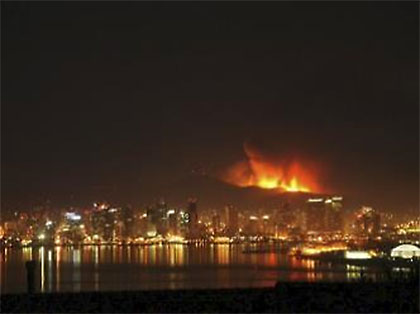
View of downtown San Diego during the 2007 Harris Fire shows how closely the fire came to destroying an entire U.S. city. UC San Diego’s HPWREN was used to monitor the fire from web stations and cameras, one of the only situational awareness tools at the time. Image: CAL FIRE Captain Bill Clayton.
The University of California at San Diego (UCSD) is awarded a grant to build an end-to-end cyberinfrastructure (CI), called WIFIRE, for real-time and data-driven simulation, prediction and visualization of wildfire behavior. San Diego Supercomputer Center (SDSC) and Calit2’s Qualcomm Institute will build this integrated CI system for supporting social-ecological resilience to the changing fire ecology regime in the face of urban dynamics and climate change, together with collaborators from UCSD’s Jacobs School of Engineering and UMD’s Department of Fire Protection Engineering. The WIFIRE CI integrates networked observations, e.g., heterogeneous satellite data and real-time remote sensor data, with computational techniques in signal processing, visualization, modeling and data assimilation to provide a scalable, technological, and educational solution to monitor weather patterns to predict a wildfire’s Rate of Spread. Our collaborative WIFIRE team of scientists, engineers, technologists, government policy managers, private industry, and firefighters will architect and implement CI pathways that enable joint innovation for wildfire management. Scientific workflows will be used as an integrative distributed programming model and will simplify the implementation of engineering modules for data-driven simulation, prediction and visualization while allowing integration with large-scale computing facilities. WIFIRE will be scalable to users with different skill-levels via specialized web interfaces and user-specified alerts for environmental events broadcasted to receivers before, during and after a wildfire. The approach is scalable which allows many sensors to be subjected to user-specified data processing algorithms to generate threshold alerts within seconds. Integration of this sensor data into both rapidly available fire image data and models will better enable situational awareness, responses and decision support at local, state, national, and international levels.
The products of WIFIRE will be initially disseminated to project collaborators (SDG&E, CAL FIRE, USFS), covering academic, private, and government laboratories while generating value to emergency officials, and consequently to the general public. WIFIRE may be used by government agencies in the future to save lives and property during wildfire events, test the effectiveness of response and evacuation scenarios before they occur and assess the effectiveness of high-density sensor networks in improving fire and weather predictions. WIFIRE’s high-density network, therefore, will serve as a testbed for future applications worldwide. The team is inclusive across a spectrum of collaborators and will create an open-source CI environment with intuitive workflows that lead to reusable software components for a wide range of science and engineering disciplines that can be extended to secondary education. Results are disseminated via an interactive website at SDSC in which students from high school to graduate level can participate in uploading their own data logging, data processing or data-driven alerts.
http://www.nsf.gov/awardsearch/showAward?AWD_ID=1331615&HistoricalAwards=false
http://www.research.gov/research-portal/appmanager/base/desktop?_nfpb=true&_pageLabel=research_news&_nfls=false&nodePath=/researchGov/News/Common/InwakeofHurricaneSandyOklahomatornadoesNSFawards32millioninhazardssustainabilitygrants.html
http://www.lajollalight.com/2013/10/17/research-report-%E2%80%98wifire%E2%80%99-developed-to-predict-wildfire-behavior/
http://www.sdsc.edu/News%20Items/PR092613_wifire.html
